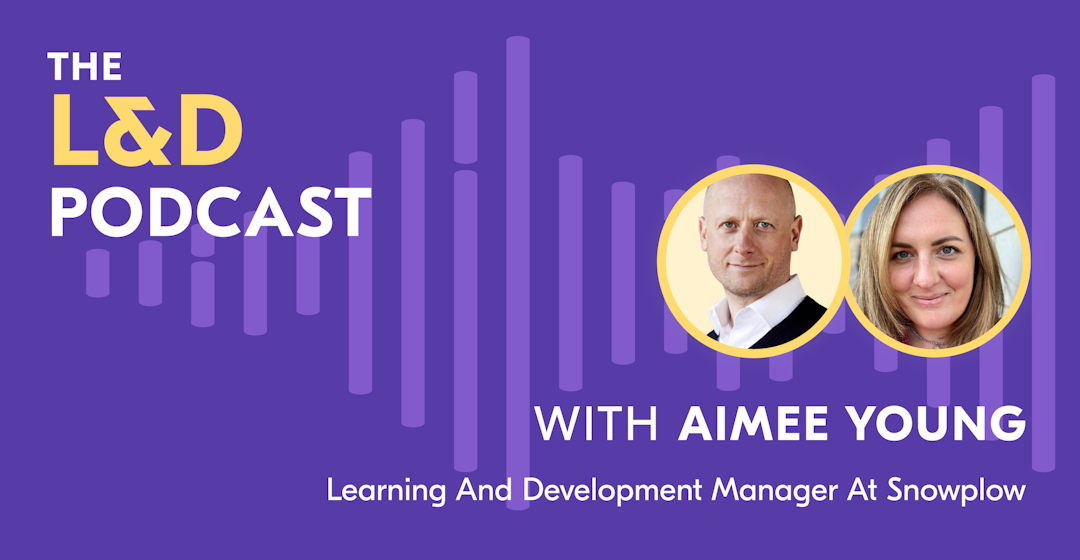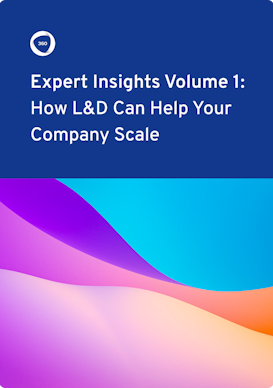
Exciting, Lonely, and All-Encompassing: The Role of Standalone L&D With Aimee Young
L&D roles can vary greatly depending on the individual’s specialism, ambition, and opportunities within any team.
But the chance to take on a standalone L&D department is a unique experience that brings as much freedom and excitement as it does challenges and resourcefulness.
In this podcast recap (check out the full episode here), I speak with Aimee Young, L&D Manager at Snowplow, about her L&D journey, what running a department solo looks like, and how to make standalone L&D a successful career move of choice.
Read on to hear about the difference between standard and standalone L&D and Aimee's mindset to making an impact on your own.
Loving what you’re reading? Come and join the L&D Collective for more great learning insights, resources, and events!
Standalone L&D: different things to different people
As Aimee explains, standalone L&D means a lot of different things to different people.
“In the standalone roles I've previously had,” she says, “I've been everything from learning and development manager to HR generalist to coach to an early careers advisor and from recruiter to trainer. It is all-encompassing and depends on the size of the organization you are in.”
In the context of a scale-up, where Aimee is now at Snowplow, she says you have to roll up your sleeves, get involved, and give everything a go within reason. “As standalone, you’re that person that people come to for all things learning and development. But it’s important to know your limits.”
“Depending on the organization's understanding of learning and development, standalone L&D can be awesome because you get to shape it. You get to be the voice for it, and it's an amazing challenge.”
Depending on the organization's understanding of learning and development, standalone L&D can be awesome because you get to shape it. You get to be the voice for it, and it's an amazing challenge.
Why context-switching is critical in standalone L&D
In Aimee’s experience, the first big challenge is that standalone L&D can be isolating.
“If you're going to define what learning and development is, it is enacting behavioral change. That's really what we're there to do. But sometimes, people just don’t understand what L&D is,” says Aimee.
“So, you can get pushback and people saying, ‘No, I don't want to do that. I don't want to improve this process. I don't want to change that’. And then you can feel like, ‘Gosh, I've got no one to talk to. Nobody understands why I'm trying to do this’,” says Aimee.
In standalone L&D, she says you have to get good at context-switching. “One minute, I'm aligning L&D strategy to company OKRs, and the next, I'm coaching the leadership team. I'm doing individual contributor training on personal brand and writing a blog post on well-being. I'm thinking about the L&D brand and what a button looks like in an LMS.”
“So, you must switch all the time. I love it. Otherwise, I wouldn't be talking to you about it. But you've got to get really good at that context-switching and planning your time.”
Looking for more tips on how to scale your L&D practice? Find out how L&D leaders at Amazon, WhatsApp, Klaviyo and more are driving growth with the right L&D strategy.

You have questions–the experts have the answers
By downloading, you agree to our privacy policy.
Key L&D skills and experiences you need to thrive
Aimee started her “luxurious, squiggly career” as a primary school teacher, where she learned the basics of curriculum and lesson planning.
“My first role was in a much smaller team with Towards Maturity,” she explains. “That role taught me so much about reading and understanding data, storytelling, being a salesperson, and being a consultant. It was incredible, and I used to tell stories through data.”
Next, Aimee began a role as an L&D assistant at a Law Firm where she learned everything she needed to know about the barebones of L&D. “That is event planning, organization, budgets, and how to assess the needs–does someone really need training? Or do they not?”
Being a part of this bigger team of five or six people was helpful for the learning element because Aimee understood so much more about the whole learning life cycle.
“You get that incidental learning from other people in the team that you miss out on when you're standalone. People share reports and research with you and are as passionate as you are about what you do.”
And from that experience, Aimee now understands the end-to-end cycle when someone tells her they want to go on a course. “And am I the best person to help you? Or do we have somebody else who could help you? Do we need to pay for this? Or is there someone else that we could set you up with as a mentor or coach?”
“There's all this stuff I've got exposed to through working in a bigger team that I wouldn't have necessarily known about had I only ever been in standalone.”
Related: Empathy-Focused L&D: Quantum Health’s 5 Steps to Being a Successful Learning Business Partner
How to make the role of standalone work
First, Aimee explains that you’ve got to do away with that ego. “Leave it at the door,” she says. “You cannot have an ego if you are a standalone L&D department. You have to do the thing, whatever it is, and just get on with it.”
This includes:
- Building your connections
- Gathering your data
- Being clear about what L&D is within the organization
- Having service-level agreements
- Treating yourself like a business
- Being a consultant for all of your clients
“The biggest thing to learn is to get over the fact you don't have an L&D team with you. In standalone L&D, your team is the leadership team, every individual contributor, and every subject-matter expert in the organization. They're your L&D team now.”
The biggest thing to learn is to get over the fact you don't have an L&D team with you. In standalone L&D, your team is the leadership team, every individual contributor, and every subject-matter expert in the organization. They're your L&D team now.
“Just because you are seen as the L&D expert in the team it doesn't mean you have to do all the tasks. So make friends, network, and get them to do it with you. That's key.”
What standalone L&D looks like at Snowplow
As Aimee explains, Snowplow is a behavioral analytics platform doing exciting work around data creation, helping data teams drive business impact.
“I love it because it's so reminiscent of what L&D should be doing,” she says. “It’s so closely aligned to L&D using data properly. We're not measuring bums on seats and all that rubbish. We’re measuring actual business impact and having real conversations around what is working and what isn't working.”
Defining her role at Snowplow, Aimee would describe it as performance improvement and engagement, but more recently, it has also crossed over into organizational design. “At the moment, I'm running two programs. One for individual contributors and one for leadership teams. I do all the training in-house or bring in SMEs to deliver the material.”
“When I talk about brand, tone of voice, and what you want your L&D department to be known for, I'm extremely deliberate about calling it behavioral skills instead of soft skills,” Aimee explains. “I don't want the word soft anywhere near L&D at all. We're behavioral analytics, and I ensure we create this behavior change within the organization.”
Aimee also runs change management sessions, is the in-house coach, runs onboarding, and is just about to start a project on succession planning. “I'm heavily involved in calibration and performance mapping. I also look after our post-survey and engagement survey, and I translate that into tangible action,” she says.
Related: Beyond Education: An Exploration of Learning Design Maturity With Nick Shackleton-Jones
Paving the path to success through a personal learning network
As Aimee explains, everyone who knows her knows she talks about her personal learning network, or PLN, frequently.
“I'm obsessed, and I'm on Twitter and LinkedIn constantly, purely because I just love engaging with people and their thinking. One of the greatest things that Towards Maturity gave me was a PLN. I still speak to my clients from six years ago, and they're part of that network I'll go to for guidance and advice now that I'm in the standalone role.”
“I think it's important that you get involved, and even if you are a little bit scared to contribute to the conversation online, it’s fine; just listen in. Get involved, listen to podcasts, read blogs, and meet people. The network out there is really friendly. Everybody wants to help you. It's vitally important that you're connected externally.”
In Aimee’s experience, the L&D Collective has also been very helpful in keeping her standalone L&D fresh. “There's a whole start-up, scale-up channel in there, and I'm just in there all the time. And I'm a voyeur. I'm just listening, taking it all in.”
Parting tip: Find your inspiration anywhere
In Aimee’s experience, external networking when starting a new standalone L&D role is really important.
"All that incidence of learning I talked about earlier that you miss out on in being part of a wider team, you find it elsewhere. You can go and find it.”
“Please look after yourself. You can't do it all. Remember your brand and what you want to be known for, and stick to that. L&D is not fluffy, cute, or soft. It’s strategic, measurable, and it matters. Being standalone, you've got the chance to pave the way for impactful performance improvement. And so, it’s genuinely exciting.”
Thanks to Aimee for sharing her journey to standalone L&D and her experience and insights on how to make your solo practice a success! Keen to learn more from L&D experts? Check out my conversation with Matthew Gjertsen about how his former roles as a US Air Force Instructor Pilot and Training & Development Manager at SpaceX shaped his L&D perspective of impacting performance.
Want more peer insights on transforming workplace learning? Sign up to become a member of the L&D Collective, and check out our other #CLOConnect interviews with top L&D leaders on driving growth and scaling culture through Collaborative Learning. Or you can subscribe (below 👇) to our weekly newsletter to receive our latest posts directly in your inbox.

